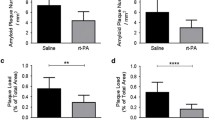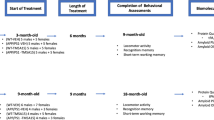Abstract
Alzheimer’s disease (AD) is the leading cause of cognitive decline in aged individuals. The pathological hallmarks of AD include the formation of neurofibrillary tangles, along with senile plaques that are mainly composed of the amyloid-β (Aβ) peptide. Several lines of evidence implicate the tPA/plasmin system in AD. One type of cell death observed in AD is excitotoxic neuronal damage, and the tPA/plasmin system participates in excitotoxic cell death. Recent in vitro experiments report that the addition of aggregated Aβ peptide to primary cortical neurons leads to the up-regulation of tPA mRNA expression. Additionally, plasmin (activated by tPA) attenuates Aβ neurotoxicity by degrading the peptide and rendering it inactive. However, there is no evidence to demonstrate an in vivo contribution of the tPA/plasmin system in AD. We are currently examining the effects of the tPA/plasmin system on the deposition and toxicity of the Aβ peptide with in vivo paradigms of AD. We hope to define the contribution of the tPA/plasmin system in the development of AD pathology.
Similar content being viewed by others
References
Chen Z.-L. and Strickland S. (1997) Neuronal death in the hippocampus is promoted by plasmin-catalyzed degradation of laminin. Cell 91, 917–925.
Citron M., Oltersdorf T., Haass C., McConlogue L., Hung A. Y., Seubert P., et al. (1992) Mutation of the β-amyloid precursor protein in familial Alzheimer’s disease increases β-protein production. Nature 360, 672–674.
Duff K., Eckman C., Zehr C., Yu X., Prada C. M., Pereztur J., et al. (1996) Increased amyloid-β 42(43) in brains of mice expressing mutant presenilin 1. Nature 383, 710–713.
Eckman E. A., Reed D. K., and Eckman C. B. (2001) Degradation of the Alzheimer’s amyloid β peptide by endothelin-converting enzyme. J. Biol. Chem. 276, 24,540–24,548.
Franklin K. B. J. and Paxinos G. (1997) The Mouse Brain in Stereotaxic Coordinates. Academic Press, Inc., San Diego, CA.
Frautschy S. A., Horn D. L., Sigel J. J., Harris-White M. E., Mendoza J. J., Yang F., et al. (1998) Protease inhibitor coinfusion with amyloid beta-protein results in enhanced deposition and toxicity in rat brain. J. Neurosci. 18, 8311–8321.
Haass C., Schlossmacher M. G., Hung A. Y., Vigo-Pelfrey C., Mellon A., Ostaszewski B. L., et al. (1992) Amyloid β-peptide is produced by cultured cells during normal metabolism. Nature 359, 322–325.
Iwata N., Tsubuki S., Takaki Y., Shirotani K., Lu B., Gerard N. P., et al. Metabolic regulation of brain Aβ by neprilysin. Science 292, 1550–1552.
Kingston I. B., Castro M. J., and Anderson S. (1995) In vitro stimulation of tissue-type plasminogen activator by Alzheimer Amyloid beta-peptide analogues. Nat. Med. 1, 138–142.
Sappino A.-P., Madani R., Huarte J., Belin D., Kiss J. Z., Wohlwend A., and Vassali J.-D. (1993) Extracellular Proteolysis in the adult murine brain. J. Clin. Invest. 92, 679–685.
Schmued L. C. and Hopkins K. J. (2000) Fluoro-Jade B: a high affinity fluorescent marker for the localization of neuronal degeneration. Brain Res. 874, 123–130.
Selkoe D. J. (2001) Alzheimer’s disease: genes, proteins, and therapy. Physiol. Rev. 81, 742–760.
Tanzi R. E., Kovacs D. M., Kim T.-W., Moir R. D., Guennette S. Y., and Wasco W. (1996) The gene defects responsible for familial Alzheimer’s disease. Neurobiol. Dis. 3, 159–168.
Tsirka S. E., Gualandris A., Amaral D. G., and Strickland S. (1995) Excitotoxin-induced neuronal degeneration and seizure are mediated by tissue plasminogen activator. Nature 377, 340–344.
Tsirka S. E., Rogove A. D., and Strickland S. (1996) Neuronal cell death and tPA. Nature 384, 123–124.
Tsirka S. E., Rogove A. D., Bugge T. H., Degen J. L., and Strickland S. (1997) An extracellular proteolytic cascade promotes neuronal degeneration in the mouse hippocampus. J. Neurosci. 17, 543–552.
Tucker H. M., Kihiko M., Caldwell J. N., Wright S., Kawarabayashi T., Price D., et al. (2000a) The plasmin system is induced by and degrades amyloid-beta aggregates. J. Neurosci. 20, 3937–3946.
Tucker H. M., Kihiko-Ehmann M., Wright S., Rydel R. E., and Estus S. (2000b) Tissue plasminogen activator requires plasminogen to modulate amyloid-beta neurotoxicity and deposition. J. Neurochem. 75, 2172–2177.
Vassalli J.-D., Sappino A.-P., and Belin D. (1991) The plasminogen activator/plasmin system. J. Clin. Invest. 88, 1067–1072.
Vekrellis K., Ye Z., Qiu W. Q., Walsh D., Hartley D., Chesneau V., et al. (2000) Neurons regulate extracellular levels of amyloid beta-protein via proteolysis by insulin-degrading enzyme. J. Neurosci. 20, 1657–1665.
Wyss-Coray T., Masliah E., Mallory M., McConlogue L., Johnson-Wood K., Lin C., and Mucke L. (1997) Amyloidogenic role of the cytokine TGF-β1 in transgenic mice and Alzheimer’s disease. Nature 389, 603–606.
Author information
Authors and Affiliations
Corresponding author
Rights and permissions
About this article
Cite this article
Melchor, J.P., Pawlak, R., Chen, Z. et al. The possible role of tissue-type plasminogen activator (tPA) and tPA blockers in the pathogenesis and treatment of Alzheimer’s disease. J Mol Neurosci 20, 287–289 (2003). https://doi.org/10.1385/JMN:20:3:287
Received:
Accepted:
Issue Date:
DOI: https://doi.org/10.1385/JMN:20:3:287




